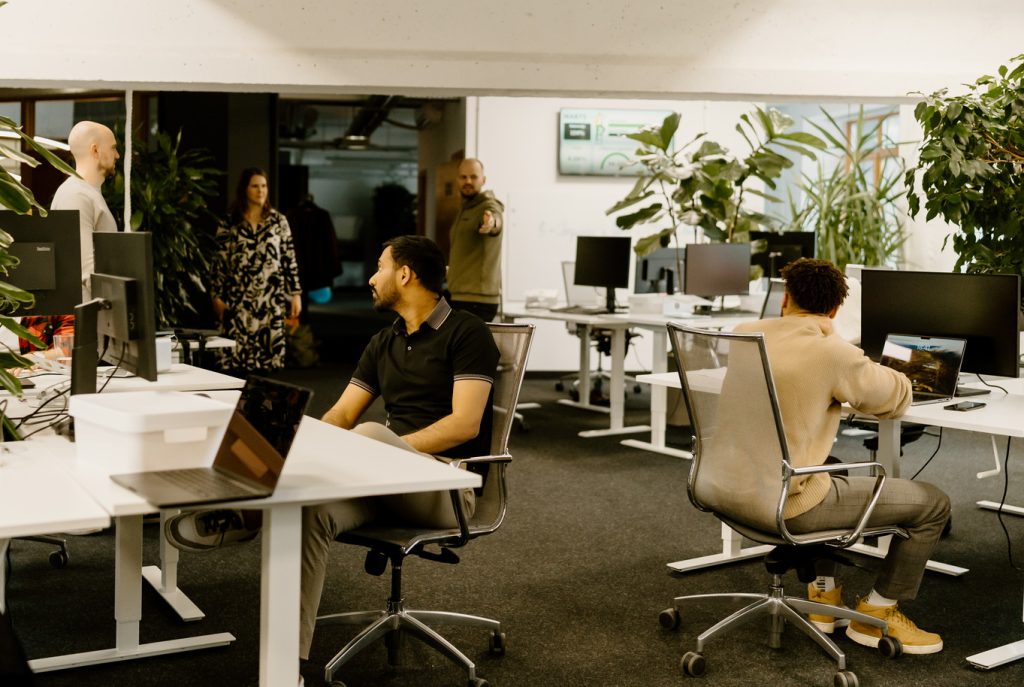Productive work environment: Types, elements, best practices

Creating a productive work environment for your team isn’t easy, especially with everyone scattered across different locations. When you manage people in different time zones, your work gains layers upon layers of complexity. Just thinking about setting up a virtual meeting with the entire team can make your head spin.
But this is the current state of work, and remote teams do have undeniable advantages. So, the only thing you can do is find ways to adjust and build a strategy that suits your unique team’s dynamics.
That’s what we’re here to discuss today: the tools and strategies you can use to create an efficient work environment for everyone involved. For instance, tools like DeskTime can help you track everyone’s time, oversee progress, and optimize productivity.
Additionally, whether you’re managing in-office staff or leading a fully remote team, you first need to understand the different types of productive environments and the key elements that contribute.
So, today, we’ll have a more in-depth look at what it means to create a productive work environment for everyone and why managers have a critical role in it.
Want to get the most out of your time?
Try DeskTime for free!
Try free for 14 days · No credit card required.
By signing up, you agree to our terms and privacy policy.

Types of productive work environments
We’re sure you know by now that surroundings affect productivity. This is the main reason why companies invest in remote workers’ home offices and why on-site offices have break rooms and other accommodations.
But ping-pong tables and ergonomic chairs aren’t the only elements of a good work environment. You have to be aware of the three key types of work environments – physical, cultural, and digital – that play a major role in how productive your team is.
Understanding each type helps you create spaces where both creativity and efficiency can thrive.
1. The physical work environment
Whether at the office or in a home office, ergonomics plays a big part in keeping your team comfortable and productive. Simple things like adjustable chairs, desks, and eye-level screens make all the difference.
Natural light also brightens up any workspace, keeping spirits high and energy flowing. These are all staples of pre-pandemic work times when almost everyone was in the office.
Nowadays, teams are usually scattered between home and office, so maintaining a productive physical work environment is much more difficult. This has led to the emergence of hybrid work environments that mix office vibes with home comfort.
Still, not all companies can afford to make this switch right away. Office transitions are usually costly, especially if you have to move to a new location that’s better suited for your needs. If this is the case, you may want to use a moving cost estimate tool to get an idea of the type of budget you need to set aside.

2. Digital work environment
Your digital work environment (the apps, OS, and other software tools used) is as important as the physical one. But, instead of furniture and quiet spaces, you need effective communication platforms and project management tools to keep things running smoothly.
Tools like Slack and Trello help teams stay connected, organized, and on track. They allow you to share ideas quickly or manage tasks efficiently across time zones. Seamless integration of these systems ensures better internal communication without jumping between too many apps or risking miscommunication.
If you have remote team members, it’s crucial to consider the cybersecurity aspects as well. You need solid security measures and well-designed policies to guard against threats that could compromise company information or disrupt workflows.
3. Cultural work environment
A positive work culture keeps team spirits high, even when everyone’s miles apart.
To encourage connections between team members, organize regular virtual meetups where colleagues share their life experiences (no talk about current tasks allowed). You can also put together engaging activities, like online quiz evenings or themed video calls.
If possible, get the team together at least once a semester and participate in team-building events. After all, one of the main benefits of team building is improved morale, which usually leads to stronger bonds between team members. When this happens, your team will act like a self-powering unit, and productivity will be at an all-time high.
Key elements of a good work environment
Now that you know the key work environments to consider, let’s have a look at elements of a good work environment that drive motivation and keep people productive even when they’re not in an office.
1. Effective communication
Effective communication forms the backbone of a productive work environment.
This is why remote workers often struggle to connect with the rest of the team. They miss out on spontaneous in-office interactions, like grabbing coffee or lunch, which usually solidify the connection between employees.
To overcome this challenge, it’s crucial to establish clear, reliable communication channels within remote teams. Whether using video calls for face-to-face conversations or instant messaging for quick updates, these platforms help maintain connection and clarity.
Also, check in at regular intervals. Set aside 10 to 15 minutes for each remote employee at the end of each week to ask about their week, allow them to voice concerns, and check if they feel aligned with company goals.
2. Strong leadership and soft skills
Strong leaders need essential soft skills like empathy, active listening, and conflict resolution to truly thrive. These qualities help create an open, supportive and productive work environment where team members feel valued and understood.
To keep these skills sharp and grow as a manager, you need to apply your knowledge constantly and stay up-to-date with the trends. It’s also a good idea to participate in soft skills training programs for managers designed to enhance your managerial abilities.

3. Motivation and recognition
People want to know their efforts matter, which is why recognition programs play a vital role in boosting morale and maintaining productivity.
When employees feel appreciated, they’re more engaged and motivated to contribute their best efforts. Simple gestures like acknowledging achievements in an all-team meeting or offering incentives can significantly uplift team spirit.
But you have to be careful about how you award the recognition. If you don’t use a transparent system and employees don’t feel like they have an equal chance at receiving the reward, motivation, and productivity will most likely vacate the premises.
Luckily, this problem can be solved easily using a structured feedback approach, like the STAR method (Situation, Task, Action, Result). This is a fantastic tool for giving constructive feedback and recognition effectively.
It allows managers to provide clear examples of an employee’s performance by outlining specific situations, the tasks involved, actions taken by the individual, and results achieved.
4. Work environment flexibility
Whether you’re working with remote, hybrid, or regular teams, work schedule and location flexibility are essential. Starting with millennials, younger workers prefer companies that are lenient when it comes to when and from where they work.
Flexible working hours and locations empower individuals to manage personal responsibilities alongside professional tasks without feeling overwhelmed. However, you need the right tools to support this level of flexibility.
Tools like DeskTime offer managers an effective way to oversee flexible environments without resorting to micromanagement. Real-time tracking capabilities help maintain accountability while respecting employees’ independence.
Providing flexible benefits further complements these efforts by catering directly to diverse needs within your team. This is where an employee benefits administration system that lets you structure packages tailored for various lifestyles will come in handy.

Looking for ways to up your business?
Use DeskTime for time management, and always stay on top of your team’s efficiency ratings!
5. Technology and tools
You can’t have a productive and efficient remote work environment without the help of technology and tools. These play a crucial role in modern workplaces, driving efficiency through automation.
Advanced tools can automate routine tasks so employees can focus more on strategic work that adds value. For example, automated scheduling or data entry can save hours of manual labor each week.
Integrating productivity tools enhances this further by creating a seamless workflow across different platforms. DeskTime excels in this area by integrating with various applications to streamline productivity tracking.
Whether syncing with calendar apps for time management or connecting to project management software like Asana or Trello, it offers comprehensive insights into how teams utilize their work hours.
Best practices for maintaining an efficient work environment
To build a productivity-oriented team, you need more than great tools aligned for the right type of work environment. You also need effective strategies that support your growth and efficiency.
So, let’s have a look at some of the best practices for maintaining a productive work environment, especially when you’re dealing with hybrid and remote teams.
1. Regular assessments and feedback
You need to be able to evaluate your team as a whole and each member separately. This is why you need tools that help you gather performance metrics that accurately depict everyone’s efforts and achievements.
Tools like DeskTime provide real-time insights into how time is spent, highlighting areas that may need improvement.
But it’s not just about you giving feedback to the team – they must also feel free to give feedback to you, the manager, and the company. By listening to their input and making necessary adjustments, you can create a more responsive workplace where everyone feels heard.

2. Promoting team bonding
A cohesive team collaborates effectively, communicates openly, and supports each other. This unity boosts productivity, fosters creativity, and ensures smoother project execution. In short, a well-connected team thrives together!
However, this level of cohesion and trust is difficult to achieve when working with hybrid and remote teams. This is why you have to build a strong culture and find ways to promote team bonding.
Regular team-building activities bring everyone together, strengthening relationships and boosting morale. Whether it’s an online trivia night or a virtual escape room, these fun interactions create shared experiences that deepen connections.
Incorporating both virtual and live events can keep the energy high across distributed teams. Celebrations like birthdays or work anniversaries are perfect opportunities to gather remotely via video calls, letting colleagues join from anywhere while enjoying social moments together.
3. Balancing flexibility with accountability
A certain flexibility with schedule and location doesn’t mean everyone can do whatever they please. This is why tracking employees’ hours is necessary, even when dealing with seasoned professionals. Team cohesion is important, and this is challenging enough to maintain without having people skip work because they don’t feel like it.
As the manager, you have to find a balance between flexibility and accountability. Start by setting clear expectations to lay the foundation for a thriving, flexible work environment. When you establish guidelines and accountability measures, you make sure employees understand their roles and responsibilities while enjoying autonomy in their schedules.
Monitoring tools, like DeskTime, become crucial here, striking a balance between freedom and oversight. Such a tool provides real-time insights into team productivity without resorting to micromanagement.
4. Health and wellbeing initiatives
Health and well-being initiatives are vital for a productive work environment. Just make sure they create value for your employees.
For instance, initiatives that support mental health are welcome in remote and hybrid settings where employees may feel left out. Offering resources like counseling services or mindfulness workshops helps address stress and emotional challenges.
Additionally, encourage your team to stay active by promoting simple habits like regular breaks to stretch between meetings. Virtual fitness classes are also a great option, but walks in nature, participating in team sports, or a few sessions per week at the local gym are just as beneficial.
Office workers usually have a sedentary lifestyle, and people who work from home move even less since they skip the morning commute or the lunch walk to the nearest restaurant. Physical exercise keeps them healthy and energy levels high even when working, so it’s essential for a productive work environment.
Virtual wellness events like guided meditation sessions or healthy cooking demonstrations are also a great way to bring the team together and discuss diverse interests. You can add a sprinkle of feel-good emotions by sending personalized, custom-made digital invitations to the event.

Create a productive work environment today
Fostering an efficient work environment is essential for any thriving organization, and managers play a pivotal role in nurturing it.
But the tools and elements you use also play a big part. From flexible schedules to effective communication and health initiatives, everything works together to enhance the team’s performance.
Ready to elevate your team’s efficiency? Consider exploring DeskTime as your go-to solution for managing productivity across varied environments. Its comprehensive features allow you to monitor progress seamlessly without overstepping into micromanagement territory.
In summary, to create a productive work environment where everyone can excel, managers must take in and understand the fundamental insights we discussed today.
Did you find this article useful? Give it a clap!
Psst! You can clap more than once if you really loved it 🙂